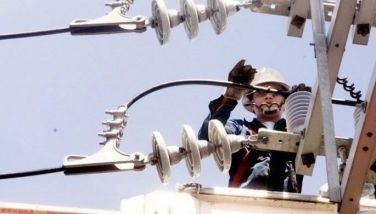How our public infrastructure went poor -- A historical view

Infrastructure investment is high on the list of issues that all the candidates for president keep harping on. So much is being promised by all.
The biggest failure of the administration of President Aquino is in public infrastructure. True, he has widened the national highway system across the islands, but on the whole, he was more active in improving the process of review and contracting than in speeding up project implementation. He also stopped projects already on the way toward implementation by the previous administration.
Infrastructure expansion is a long run proposition. Presidential terms are only for six years. During the last three decades, infrastructure quality has not kept pace with the country’s needs. It signals failure of leadership on this score.
Before 1986: People Power revolt. As the 1980s opened, Philippine infrastructure was on course to be among the forward-looking programs in the ASEAN.
Of the original ASEAN five (Indonesia, Malaysia, Philippines, Singapore, Thailand), the infrastructure facilities of the Philippines were at par with Thailand then, which was among the high growth economies of the region, and well ahead of Indonesia.
This was on the collective mix of investments -- in roads, ports, in agricultural and industrial infrastructure. Infrastructure investment covered the country’s three main islands, each area being quite substantial.
To deal more effectively with infrastructure construction, the government split the original infrastructure ministry so the units could focus more fully ontheir individual mandates – public works, road transport, and telecommunications. To consolidate the energy response to the oil crisis, the ministry of energy focused on power generation.
Various institutional services to support infrastructure were given corporate structures to enable them to plan and implement efficiently.
Corazon Aquino, 1986-1994. When she assumed office, Cory Aquino had inherited this extensive public infrastructure supporting economic development. Unfortunately, that legacy was not fully and effectively harnessed for the nation. Some of it was scuttled and quite a number of ongoing projects were stopped in their tracks.
The political program of retribution against Ferdinand Marcos led her to dismantle part of that important legacy. The most well-known of this was the abolition of the energy ministry. That act reduced the program’s focus on energy development during this period. Moreover, she scuttled the nuclear power plant that was ready to come on stream.
This action led to the electricity crisis of the 1990s – a very sad economic episode for the whole nation.
The Cory Aquino presidency exhausted part of the public infrastructure put in place by the Marcos administration. Hardly much was added by way of new construction and so much of existing infrastructure deteriorated for lack of maintenance.
The reason, of course, was that the country had a tight budget constraint that could hardly make room for investments. This problem was partly self-inflicted.
Mrs. Aquino had amassed great political capital with the “people power victory over dictatorship” that a wiser leadership could have used. Instead, she embarked initially with a hostile and inexperienced approach to the country’s international creditors that closed windows of opportunity that had opened to her.
For those who wonder at this statement, the US Treasury gave an emergency lifeline to Mexico to save that country from economic disaster when a second debt problem arose again in the early 1990s. Also, just recently, the new president of Argentina, Mauricio Macri, got a sizable external loan to bring the country back to economic health.
Remember, too, that Indonesia and Thailand received massive external aid when faced with the consequences of the 1997 East Asian financial crisis.
Fidel Ramos, 1995-2000. Much of the presidency of Fidel Ramos was spent addressing the electricity gap that was left by Mrs. Aquino and paved the way for the resurgence of the building of public infrastructure. He had, in his own words, “to hit the ground running.”
Ramos was the most hardworking and talented post-1980s president of the nation. He knew where to put the economic reforms to work, beginning with the opening up of the telecommunications sector and the privatization program to free more resources for public infrastructure.
Had he labored with a better endowment of infrastructure legacy than the massive messy problems that he had inherited, he could have laid the groundwork for broader economic advance on the infrastructure front.
He was the best argument for having much longer terms for presidents while those who followed him represented the best reasons why the presidential term should be a single and even shorter one.
Gloria Macapagal-Arroyo (and Estrada) years, 2001-2010. There being little by way of infrastructure investments in the short Estrada years before he was ousted by People Power II, the next substantial stage of development was during the Gloria Macapagal-Arroyo years.
For one, her stay in office was long and exceeded the usual single term of six years. She succeeded the four years of Estrada’s unfinished term as the legal vice president before she was elected to a full term of six years.
Unfortunately, these were turbulent years, for after the “Hello, Garci” scandal (which implied a less than honest election process), her legitimacy was badly damaged, and her decisions in office became cluttered by political survival issues.
The result of this was mediocre performance in infrastructure investments. The only major program of new road construction was the SCTEX – the road connecting Subic to Tarlac and the North Expressway in Luzon.
There were improvements and expansions of the South Expressway and its expansion to Batangas, the improvement rehabilitation of existing roads and the initial programs designed to build a more extensive Ro-Ro transport system across the islands.
The main airport expansion in Manila, which was finished during this period, got locked up by an extended corruption scandal and by a decision to withhold its opening for some years.
Major infrastructure programs ended up in corruption scandals that led to them being held up or abandoned by the Aquino administration when they took over, even after significant project funds had been spent.
This was the case with Ro-Ro investments (arranged with French support) and in railway systems and telecommunications improvements (arranged with Chinese financing).
My email is: [email protected]. Visit this site for more information, feedback and commentary: http://econ.upd.edu.ph/gpsicat/
- Latest
- Trending


























